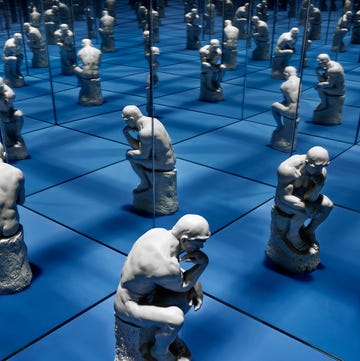Declutter Your Life is a month-long initiative to help you manage stress and boost your health by learning the principles of banishing clutter and restoring a sense of order to your world.
Bills and junk mail are piling up on your kitchen counter, dirty clothes are spilling out of the hamper onto your bedroom floor, and let’s not even talk about the state of your spare room right now. At some point or another, this has likely been your home. (If not, kudos.) And even if you don’t realize it, the disarray can mess with your mental health.
“If our home, car, and office space feel hunky and disorganized, we tend to feel overwhelmed as if we don’t even know where to start,” says Sherry Benton, PhD, a psychologist who serves as founder and chief science officer of TAO Connect. “Every task, from eating breakfast to driving to work can feel complicated by the mess we are contending with.” The opposite is true, too: “When our space feels put together and tranquil, we feel more tranquil,” she says.
Research backs this up. A 2009 study in The Personality and Social Psychology Bulletin found that women who described their homes as cluttered and stressful were more depressed than those who described them as restorative spaces. This isn’t surprising, considering plenty of studies have linked a tidier home to healthier habits—like exercising and making smart snack choices—which can really pay off for your overall health and outlook.
The problem, Benton points out, is that the relationship between your mind and your living space is often circular. “When someone is anxious, depressed, or has some sort of ADD, it can be difficult to focus on organizing one’s space.” In fact, hoarding is often a symptom of mental illness, such as depression or obsessive-compulsive disorder (OCD), according to the Anxiety and Depression Association of America. (Are you depressed or just bummed out? Take this quiz to find out.)
10 silent signals you're way too stressed out:
But for the average person, how much mess is mood-wrecking? That all depends on your personal comfort level. “Many people have areas they really want to have organized and other areas where this is less of a concern,” says Benton. “For example, I really like having my spice rack in alphabetical order, which drove my husband nuts for years. I rarely even think about organization (or lack thereof) in the garage, but he’s very particular about it.”
Take note of the clutter zones that heighten your stress or hinder your daily routine, brush up on these five no-fail decluttering strategies from a professional organizer, and schedule some time to start tidying. We know the task seems daunting, so we found inspiring transformations of six spots throughout the house that will show you exactly what to do.
Laundry room
You don't want to spend tons of time in the laundry room, which is precisely why you should take some time to declutter it. Sorting your cleaning products and designating bins for each clothing color or washing category will help you get in and out of there more quickly. Even if you're dealing with a laundry closet rather than a whole room, this makeover by blogger Kristen Erickson proves it's possible to make the most of the space you have.
For less than $100, Erickson freshened up her laundry closet's walls and installed a hanging rod and a more functional shelving unit from Pottery Barn, which she found on Craigslist for just $50. (A hanging organizer that comes with baskets, like this one from Walmart, would also work well.) Here are three ideas to steal:
- Hide clutter. Erickson found baskets at Target for $5 each that fit perfectly into her shelving unit (here's a 4-piece set of similar shelf baskets for $28 on amazon.com), and she neatly stashes dryer sheets and extra toilet paper in them.
- Put essentials within reach. And consider storing liquids like laundry detergent and softener in clear beverage dispensers (like this one, $20, target.com) to keep tabs on exactly how much you have left.
- Add the right color. Painting your laundry room a soothing hue, like soft green or eggshell, can help you relax while doing chores. A Minnesota State University study found that subjects in red rooms felt more stressed than those in green or white rooms.
MORE: 7 Simple Changes To Your Home That Fight Depression
Kitchen
More specifically, the pantry. With limited space, it's easy to cram cans and packaged items in wherever they fit, but giving your shelves a sense of order can help you choose healthier foods to eat and make meal prep less stressful. (Trying to lose weight? Here's how to organize your kitchen for success.)
Consider the amazing overhaul shown above. "The biggest issue with this pantry before it was organized is that its deep shelves make it easy for items to hide in the way back until far beyond their expiration date," says Marissa Hagmeyer, professional organizer and CMO of NEAT Method. To make things easier to locate, NEAT Method created categories based off foods the client typically has. "Labeling is a must so that you can easily maintain the system that NEAT puts in place, and to save you time when putting away the groceries and making dinner," she says. If you don't want to hire a professional, keep these tips from Hagmeyer in mind:
- Categorize. Come up with groupings that suit your stock, but avoid making them so narrow that they exclude new purchases. For instance, a "grains" category is more all-encompassing than just "rice."
- Buy organizing tools. Storage baskets and canisters "will help you contain your items and keep them fresh longer," Hagmeyer says. Airtight canisters, like the ones in this 4-piece OXO set ($22, target.com), are great for storing dry goods like flour and sugar. (These 11 products can also help keep your kitchen and pantry clutter-free.)
- Maintain. Purge expired items regularly, and always put things away in their assigned categories.
Bathroom
This room is tricky. Chances are, you're dealing with a slew of products, sometimes for multiple family members, yet only so much space to store everything. Strategically tidying your bathroom shelves, drawers, and under-the-sink storage can help you corral all of these items in a way that's convenient for everyone. And it shouldn't take you all day to do so: Rebecca Huff, a.k.a. That Organic Mom, organized her master bathroom above in just two hours (see pics of her full decluttering here.) Here's how she did it:
- Remove, sort, replace. Go through all your health and beauty products and keep only what you use. "I had three sets of makeup brushes even though I only used the same few brushes while other ones never got used," Huff writes. (Here's exactly how to organize your medicine cabinet—and what to toss.)
- Get thrifty. Huff uses a hanging shoe organizer on the bathroom door to store hair styling tools and products. "This door stays open most of the time, so it really is out of sight until I need it," she writes.
- Buy more baskets. It's Huff's favorite way to give her bathroom shelves a minimalist look while still having her products close at hand. (Digging the ones you see above? Nab a similar set at Walmart.com for $30.)
Bedroom
Plenty of sleep is critical for maintaining good health—without enough, studies show you're actually more likely to develop depression and anxiety, as well as heart disease and diabetes. And a closet that's close to bursting probably isn't giving you the peaceful vibes you need to snooze soundly. (This is what the perfect bedroom for a great night's sleep looks like.) To control the chaos in this client's bedroom (without getting rid of any clothes!) professional organizer Bridget Stralko of Unclutter It used the simplest of tactics:
- Add a shelf. An extra row of vertical storage moved homeless items up and out of the way.
- Stow away by season. Stralko stashed off-season shoes in a plastic bin to keep them off the floor. No room in the closet? These genius shoe bins with wheels ($23, thecontainerstore.com) slide neatly under your bed.
- File fold. This folding method, popularized by The Life-Changing Magic of Tidying Up, allows you to fit more clothes into drawers using less space. (Here's how this method helped one writer declutter her wardrobe and save money.)
Storage space
Does the before picture look familiar? "A lot of times spare rooms are the ones that we rarely step foot in, so it is easy to let those become your dumping ground," says Hagmeyer. "Even though the clutter is often behind a closed door, it still weighs on us because we know it needs to get dealt with eventually."
To motivate yourself to deal with the clutter now, imagine how you could better use that spare room. For instance, NEAT Method helped this particular clutter-bug turn her storage area into a craft space. Perhaps you've always intended to use yours as a home office, playroom, or workout area. Here's how to make that happen:
- Start from scratch. "You should start by taking everything out and purging as you go," says Hagmeyer. This could take you all day (or more) but will save you time in the long run.
- Use vertical space. The floor-to-ceiling shelving unit in this craft room turned an entire wall into a sorting hub. Hanging scissors and other tools keeps them visible, so they're easy to locate.
- Sort and label. Just like in the pantry, categorizing items in the spare room according to your needs takes your storage from chaotic to functional. Make your life easier and buy a good labeler (like this one for $35, amazon.com).
Office
Now that your spare room is office-ready, check out how Melissa George of Polished Habitat decluttered her desktop. Science says a messy workspace can be distracting, so keeping your workspace tidy may boost your productivity—and ease your to-do list anxiety. Begin by clearing everything off your desk: "I do a way better job weeding out unnecessary items if I start each organizing project as a blank slate instead of trying to rearrange things," George notes. Then try these organizing hacks:
- Create a system. Do this based on what you have to file away. For instance, George uses wire files to categorize notebooks, catalogs, and current magazines. "Now when new magazines come, I can put them right in the file, and they won’t get lost around the house," she writes.
- Corral odds and ends. A cheery turquoise box now stores George's pens, Post-Its, and other miscellaneous office supplies, so they're not scattered across her desk.
- Make it your style. George ordered customized binders with gold dots and made her own clay bowls to store loose paperclips and binder clips. "Considering that I spend hours a day at my desk, I wanted it to be a pretty spot that made me smile. And now it does!" (See more detailed pics of her desk decluttering here).













